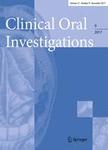版权所有:内蒙古大学图书馆 技术提供:维普资讯• 智图
内蒙古自治区呼和浩特市赛罕区大学西街235号 邮编: 010021

作者机构:Department of Nursing Chang Gung University of Science and Technology Tao-Yuan Taiwan Department of Nephrology Chang Gung Memorial Hospital in Linkou Tao-Yuan Taiwan Cardiovascular Medicine Chang Gung Memorial Hospital in Linkou Tao-Yuan Taiwan Center for Big Data Analytics and Statistics Chang Gung Memorial Hospital in Linkou Tao-Yuan Taiwan School of Medicine Chang Gung University Tao-Yuan Taiwan Department of Periodontics Chang Gung Memorial Hospital in Linkou Tao-Yuan Taiwan Chang Gung University Tao-Yuan Taiwan Center for Big Data Analytics and Statistics Department of Medical Research and Development Chang Gung Memorial Hospital Tao-Yuan Taiwan
出 版 物:《Clinical Oral Investigations》 (Clin. Oral Invest.)
年 卷 期:2023年第27卷第1期
页 面:203-211页
基 金:Ministry of Science and Technology, Taiwan, MOST, (106–2314-B-205–005-MY2) Institute for Information Industry, Ministry of Science and Technology, Taiwan, III, (MOST 106-2314-B-205-005-MY2)
主 题:Database Hemodialysis Infective endocarditis Invasive dental treatment
摘 要:Objective: The objective of this study was to determine if hemodialysis patients who have undergone an invasive dental treatment are at risk of developing infective endocarditis. Materials and methods: This study was a cohort case–control design and used secondary data collected from the National Health Insurance Research Database of Taiwan. The case group and the control group were each comprised of 19,602 hemodialysis patients. The control group was matched for four variables: age, gender, a medical history of diabetes mellitus, and a cerebrovascular event. After matching, the case group and the control group were each comprised of 19,602 hemodialysis patients. Cox regression analysis determined hazard ratios and 95% confidence intervals. Results: Patients were followed up at 1 month and 3 months after receiving invasive dental treatment. The results showed the cohort case–control hazard ratio was 0.88 (95% CI, 0.49, 1.57) 1 month after receiving invasive dental treatment. Three months after receiving IDT, the cohort case–control hazard ratio was 1.04 (95% CI, 0.71, 1.52). Hazard ratios did not differ significantly between groups. Conclusions: Hemodialysis patients who received invasive dental treatment had no greater risk of developing infective endocarditis than matched control patients. The results of this study should alleviate concerns for hemodialysis patients and dentists about invasive dental treatment procedures. We recommend hemodialysis patients undergo invasive dental treatment when needed. Clinical relevance: The results of this study showed that invasive dental treatment did not increase their risk of developing infective endocarditis. Hemodialysis patients in need of an invasive dental procedure should be encouraged to undergo treatment if the dentist deems it necessary. © 2022, The Author(s), under exclusive licence to Springer-Verlag GmbH Germany, part of Springer Nature.